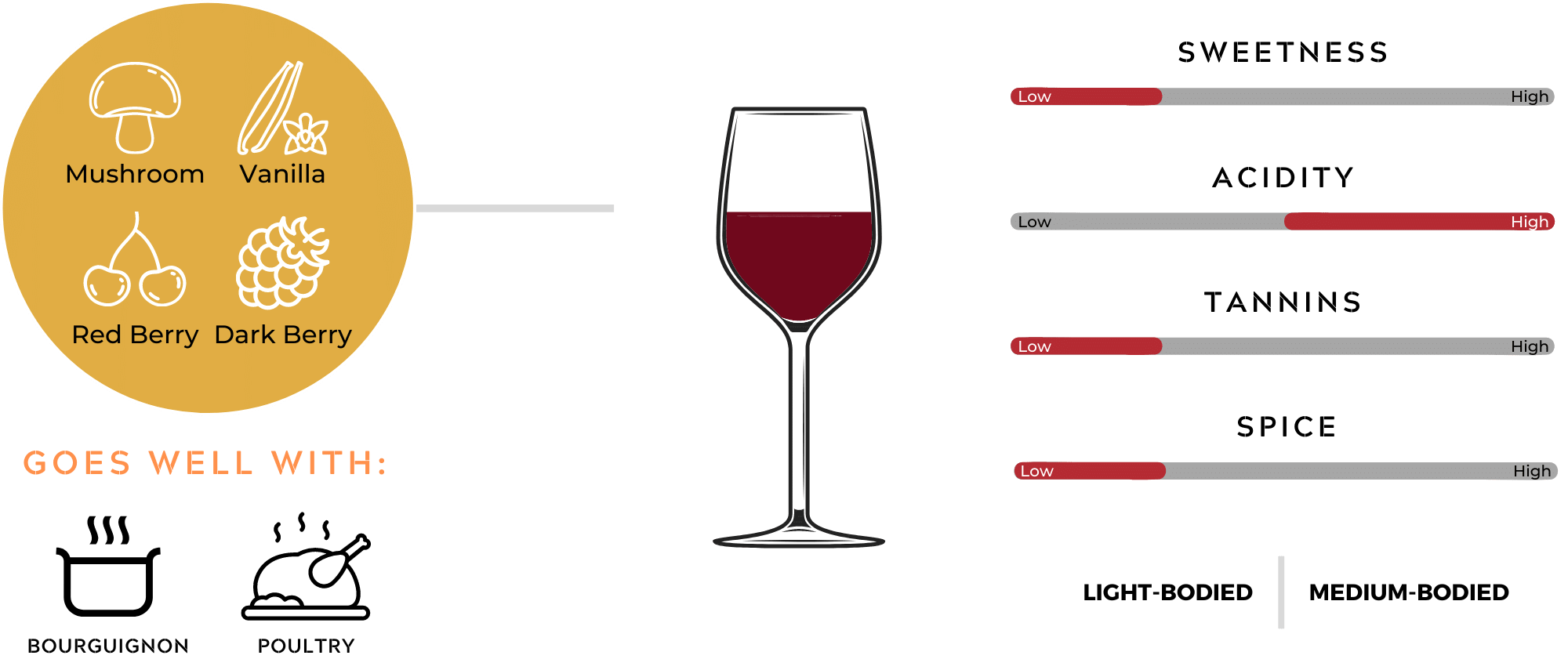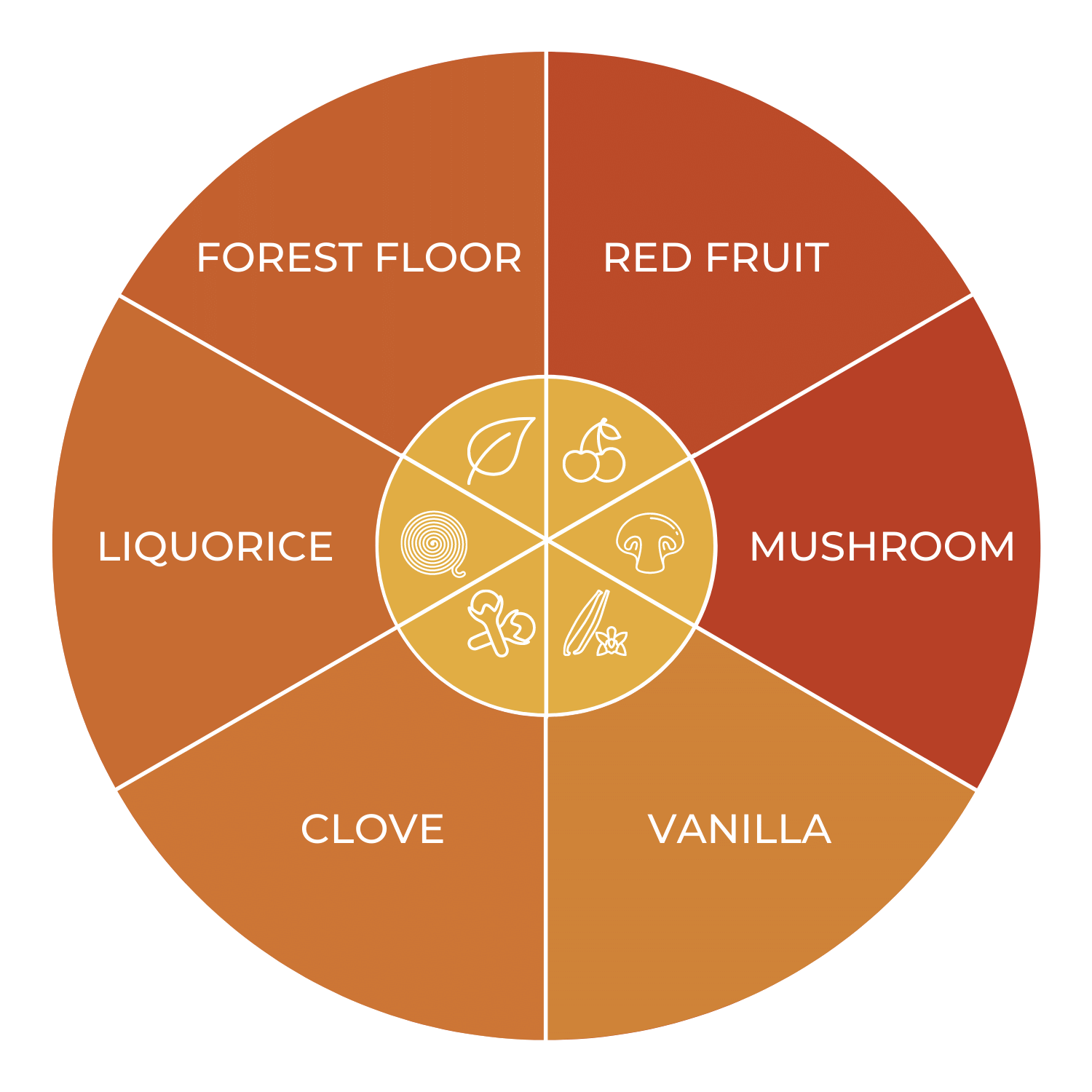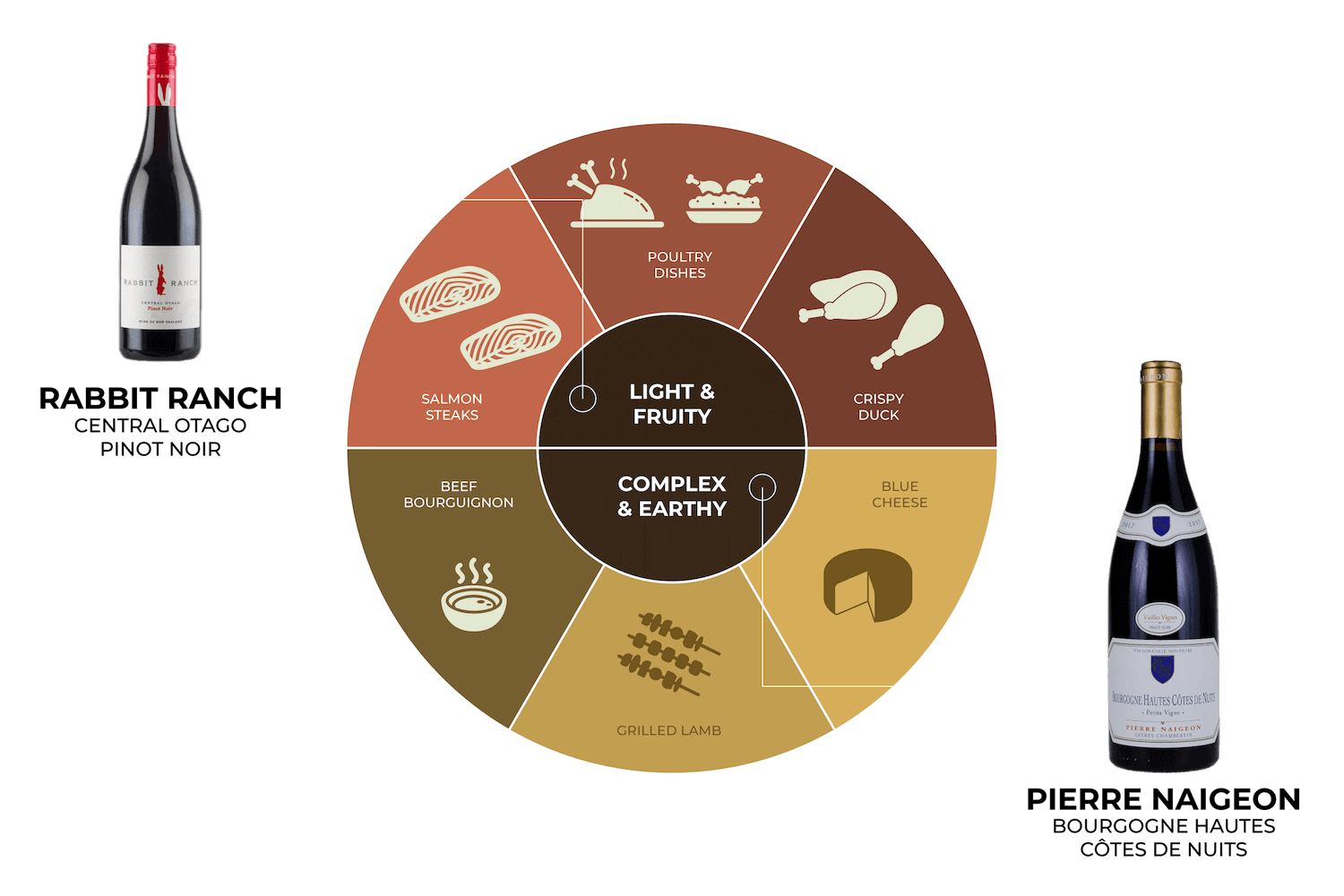Easily recognisable as one of the most popular light-bodied styles of dry red wine available, pinot noir wines are known for their soft tannins and typically higher levels of acidity.
In this guide to pinot noir, you can discover more about the common food pairing options with these reds as well as how to pick the right bottle to suit your tastes.
For a quick look into the flavour profiles of these wines and how they match with food, consider our graphic below.
The name pinot noir is derived from the French words for “pine” and “black”. Though the exact origins of the grape varietal are not entirely known, its spiritual home is found in Burgundy, France, with the wines from this region being some of the most expensive in the world.
Pinot noir grapes are notoriously difficult to cultivate and they have a clear preference for being grown in cooler climates, which often makes them more expensive to purchase than wines of other grape types.
That being said, the varietal is grown right across the world by winemakers in many different countries thanks, in part, to the complex, light, and refreshingly acidic flavour profile of the wines of this grape that makes them very enjoyable and popular to drink.
As is the case with all wines, the exact flavour profile of each bottle of pinot noir can vary greatly depending upon the specific climate the grapes used are grown in and whether the wine has been aged in oak.
Those coming from cooler climates tend to be very light-bodied in their style, with high amounts of acidity and soft cherry, raspberry, and plum notes coming through alongside hints of mushroom and even leafy forest floor.
When the wine is coming from a warmer climate, however, you can expect to find softer amounts of acidity and definitively more pronounced flavours of cherry and raspberry in what is a noticeably more light to medium bodied red.
If the winemaker chooses to age their pinot noir in oak prior to bottling, the wine will often gain added layers of flavour highly reminiscent of soft spice and vanilla, making it possible to find pinot noir wines with great levels of complexity.
When looking to purchase a bottle of pinot noir for yourself, always consider the origins of the specific bottle in question as it will tell you a great deal about what flavours you can expect to find and whether or not it will suit your tastes.
As discussed previously, pinot noir wines have a strong connection to the Burgundy region in eastern-central France, where they are native to.
Although they are grown throughout many of the other cool and even warm climate regions in France, the winemakers from Burgundy easily produce the best examples of French pinot noir available.
For those wishing to begin their pinot noir wine tasting journey in France, it is important to begin with those bottles coming from that region, known locally as “Bourgogne Rouge”.
Burgundy winemakers are famous for producing some of the most expensive and sought after bottles of wine on the market.
The region is equally as famous for producing exceptional examples of chardonnay as it is for producing stellar pinot noir, with the cool climate of the area being a key contributor to the popularity of both grapes amongst winemakers in the region.
Depending upon where the individual grapes are grown within the Burgundy region, the bottle will present with a different name on the label, denoting quality.
Wines labelled with Grand Cru use grapes coming from only the best and most select vineyards in the area, Premier Cru represents one step down from Grand Cru, though they are almost the same, Village Wines utilise grapes coming from one of the particular villages of the region, and finally, Regional Wines use a blend of grapes coming from right throughout the area, typically seen as the entry level for Burgundy wines.
Flavourwise, bottles of pinot noir coming from the Burgundy region will almost always present as very complex in their flavour profile.
Prominent flavours often include cherry, black plum, leafy tobacco, and even subtle spice, all featured within a typically medium-bodied and strongly-acidic expression of pinot noir.
To discover more about the pinot noir wines from the Burgundy region, be sure to consider this article that explores the region in more depth.
Pinot noir grapes most likely first made their way into Australia at some point during the early 19th Century, around the same time as many other varietals.
Though the grape was first cultivated in the warmer climate Coonawarra region in South Australia, it really shines through best in the cooler climates of Victoria and Tasmania, where most of the best examples today are produced.
The Yarra Valley region in Victoria is ranked as one of the best cool climate wine-producing regions in Australia.
Many of the best examples of Australian cool climate pinot noir originate from here, alongside quality examples of chardonnay and sparkling wine, much like the Burgundy region in France.
The area sits in close proximity to the major city of the state, Melbourne, making it a popular tourist destination for many local and foreign visitors.
Flavourwise, the region produces examples of pinot noir wines that are light-bodied and very approachable in their style with soft, supple berry flavours featuring prominently against more complex notes of soft spice and earthier notes of mushroom and leaf.
Tannins are often quite low in these wines although acidity is often on the higher end, making these wines excellent for those who want to ease their way into red wines in general or softer style pinot noirs.
If you’re looking to begin your pinot noir tasting experience with those bottles coming from the Yarra Valley region, we recommend you visit this site, which offers up many of the best examples.
Tasmania has burst onto the scene of late due to its recently secured stance as one of the finest wine and spirit producing states in Australia.
The island state is home to dozens of fine-wine-producing wineries, particularly in its Tamar Valley, Pipers River, and Coal River Valley regions, as well as other areas across much of the island's east coast.
The reason behind the area's prominence in producing fine white, sparkling, and red wines, lies in its wonderfully untouched natural beauty, which benefits from a cooler climate thanks to the islands closer proximity to antarctica.
When looking into the two regions most prominent in the production of fine pinot noir, it is worth checking out the Tamar Valley winery region and the areas along the east coast.
Due to Tasmania's cool, dry climate, many of the bottles of pinot noir coming from the states winery regions are known for their higher amounts of acidity and complex flavour profile, often similar in style to those wines from Burgundy.
Common flavours found will often include dark plum and raspberry, alongside notes of cherry, delicate spice, and earthier tones of mushroom, all within wines that contain smooth tannins and low sugar levels.
To discover more about the world of Tasmanian wine production, be sure to head to this site, which offers an in-depth look into all of the preeminent styles produced there.
Irrespective of whether the wine comes from a cool or warm climate, it is well understood that you should pair the higher levels of acidity and soft red fruit and berry flavours commonly found in pinot noir wines with light red or white meat dishes.
Common examples include alongside roast chicken or duck or even roast lamb or pork.
When looking for specific recommendations, more complex cooler climate pinot noir wines are optimally served with meat dishes such as beef bourguignon or any other kind of richer red meat dish, whilst those lighter and fruitier examples from warmer climates are often best served alongside seared salmon steaks or light poultry dishes, such as quail.
For other food pairing choices with the various styles of pinot noir, consider this site, which details more.
There's a bottle of pinot noir out there for everyone. Here are some of the brands and bottles that we recommend you look out for the next time you're browsing online or in-store.
Ever wondered whether or not the age of a bottle of wine matters when deciding its quality? In this article, we explore just how important age is when looking at wine.
With bottle shops expanding their range, we’ve taken the time to explain why some wines are and some are not vegan & organic in order to help you choose wisely.
Ready to begin your journey into the world of wine but don’t know where to start? Here’s our primer on what bottles & styles to try when just starting out.





